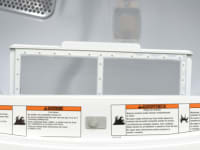8 things you need to know about generator safety
Thinking about using one indoors? Think again.
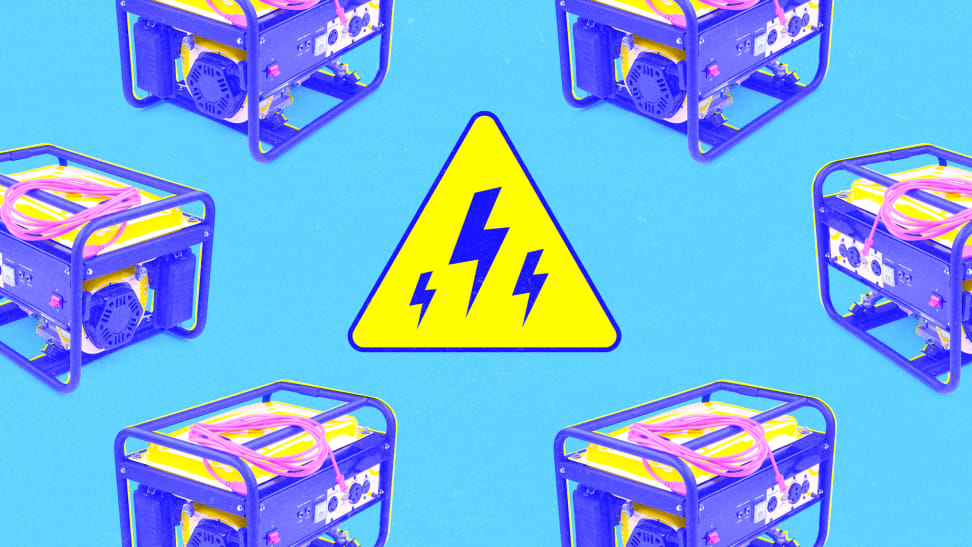 Credit:
Reviewed
Credit:
Reviewed
Products are chosen independently by our editors. Purchases made through our links may earn us a commission.
Whether you’re a homeowner or run a business (or both), a backup generator is one of the smartest investments you’ll ever make. This device can keep the power on in your house or office in the event of a blackout, making it possible for multiple appliances—such as a refrigerator, air conditioner, air purifier, or other device—to run simultaneously. Most importantly, it can give you and your loved ones peace of mind in the event of a potentially life-threatening emergency.
While the best generators can seem like the ultimate insurance against threats to your home and family, they’re not all the same. There are four main types of generators on the market: standby (or whole-house), portable, inverter, and portable power stations.
Of the four, portable and inverter generators are the most popular because they’re easy to transport and can be effective for powering everything from tools to air conditioners and more. Compared to standby generators—which require on-site installation and can cost thousands of dollars—these devices are also considered more affordable.
The catch? Inverter and portable generators can be confusing to operate and dangerous to use if you don’t take certain safety precautions. From calculating the total wattage you’ll need to using the right fuel type for your specific device, using a generator safely requires a lot of knowledge.
Fortunately, you don’t have to be a trained electrician to know how to use a portable or inverter generator. Here are some crucial safety tips to keep in mind before you rush out to buy one.
1. Never ever run a generator indoors—and keep it away from your house
There’s a lot to know about generator safety, but this is the golden rule. You should never—under any circumstances—operate one inside your home. This includes your basement and garage, as both areas are still attached to the structure.
The reason? Generators create carbon monoxide (CO), a colorless and odorless gas that can lead to death in as little as 5 minutes at certain levels due to exposure.
In order to exercise the utmost caution and reduce the risk of CO poisoning, generators must be operated in fully open, well-ventilated areas at all times. In addition, you may want to install CO detectors throughout your home.
It’s not enough to just use one outdoors, though. The threat of CO poisoning from generator usage is so high that you also need to make sure that the device is at least 20 feet away from your house or building while it’s running. Be sure to position the engine exhaust away from any doors, windows, or air conditioner units, too, as this can help reduce the risk of CO exposure.
2. Know your wattage
One of the most important aspects of safely operating any type of backup generator is choosing one that can supply the right wattage to power all your essentials. If you don’t, you run the risk of overloading your generator, which can happen with an inverter or portable generator if you’re not careful. Overloads occur when you have too many appliances plugged in, and it exceeds the total running watts that the machine can support.
This is extremely hazardous, as it can lead to overheating, resulting in damage to your devices and/or a fire. If your generator is attached to a circuit breaker, it may shut down in response, but there’s no guarantee.
Instead, the best way to avoid an overload—and thereby better protect yourself and your family—is to know exactly how much wattage you’ll need and then buy the right generator to match it.
To calculate, make a list of everything you would expect to still have running during a blackout. An inventory, including major appliances like a refrigerator or smaller devices such as a laptop or smartphone, can help you visualize your needs.
Once you’re done, add up the wattage of each device. This will give you a sense of roughly how much power you’ll need from a generator during a blackout and you can buy one that has the ability to support that.
3. Pick a generator based on total wattage
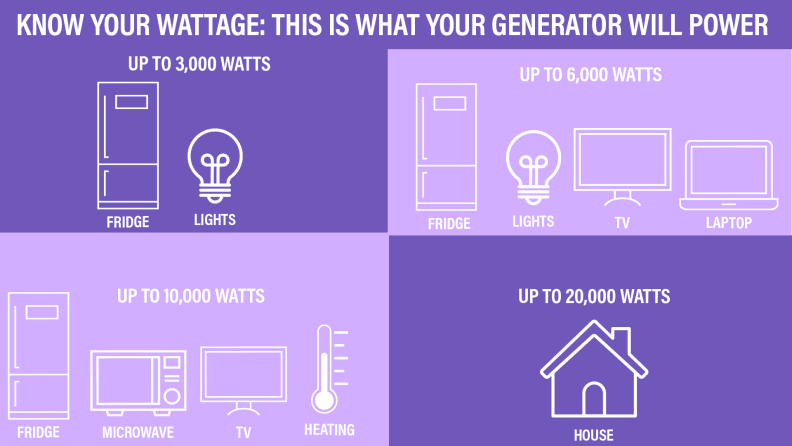
How much do you really need to keep on during an emergency? Knowing that can help you pinpoint which generator is best for you.
Unsure what to look for when it comes to wattage? Here’s a ballpark of what to look for, although these recommendations may vary based on your specific items:
Up to 3,000 watts: Best suited for basic inverter generators and good for powering up a fridge and some lights, but probably not much else.
Up to 6,000 watts: Excellent for mid-sized inverter generators and for keeping on multiple appliances at once, potentially including a refrigerator, sump pumps, lights, a television, a laptop, and possibly more.
Up to 10,000 watts: Ideal for a portable generator or large inverter generator, as you may be able to keep a fridge, microwave, central A/C unit, heating system, water heater, and potentially more fully powered.
Up to 20,000 watts: For this kind of power, portable and/or inverter generators are not the best option. You’re better off reassessing your list of essentials, or, you may want to consider investing in a standby generator.
Another thing to remember is that certain appliances (i.e. air conditioners) also require a “surge” of power to get started. If you forget to factor in this surge wattage—also known as starting wattage, and which varies by appliance—your calculations will be off and your generator might not perform as expected.
When in doubt, it’s always a good idea to consult with a trained electrician who can answer specific questions, especially as it pertains to wattage with hard-wired versus plug-in appliances.
4. Use caution during bad weather
It's dangerous to operate a portable or inverter generator in rain, snow, or wet conditions. This is because generators produce intense voltage, which can increase the risk of electrocution or possible explosions in inclement weather.
However, there is a workaround that’ll allow you to still use one in case you’ve lost power due to winter flurries or a major thunderstorm. Depending on your generator, you can grab a specially designed tent-like canopy from stores like The Home Depot and set one up over the device. A protective cover like this allows you to operate a generator safely even in the worst conditions and avoid electrocution, as well as damage to the unit.
Another option? You can forgo generator usage completely in the interest of safety and wait until the weather improves to set yours up and get power back and running.
5. Install a transfer switch—and get the right extension cords
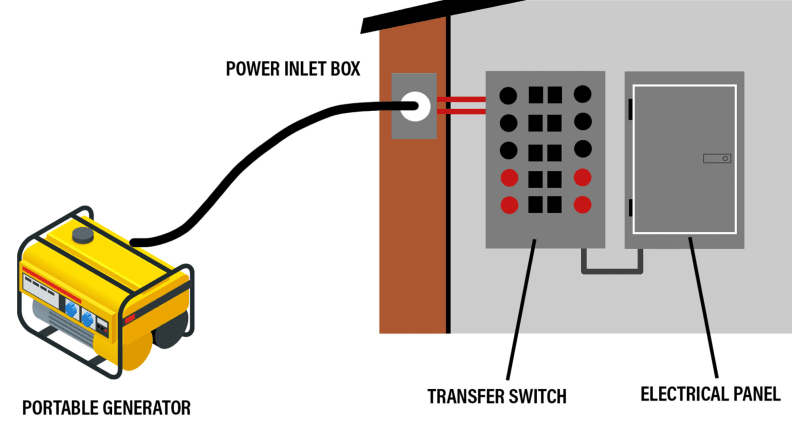
Installing a transfer switch can reduce the risk of back-feeding and protects utility workers who may be operating in the area.
Consider a transfer switch as a buffer between your generator and your house. Having one allows you to safely connect the generator to your home’s wiring and reduces the risk of back-feeding—which is extremely dangerous and can potentially deliver a deadly shock to utility workers who may be fixing power lines in the area.
Transfer switches can be automatic or manual. In many states, you need to have one installed by an electrician, otherwise you may end up voiding your fire or homeowner’s insurance (you should research this in advance to be sure). No matter what, you’ll definitely want to invest in a transfer switch before you intend to put your generator to work.
Extension cords are another crucial piece of equipment that you’ll need to operate a portable or inverter generator, but not all extension cords are created equal. Some have a better capacity to carry electricity at high wattages than others. You can pinpoint the exact cord to purchase by converting amperage (what most cords are rated by) into watts.
Typically, heavy-duty extension cords that have a grounding conductor are recommended by experts for use with inverter or portable generators, as they can provide the safest option for electricity flow. As you’re putting together a survival kit, it doesn’t hurt to have a few extra extension cords lying around, either.
6. Stock up on extra fuel
You never know what might happen, especially in the middle of an emergency. One of the most prudent things that you can do in advance is have plenty of extra gasoline, propane, and/or diesel fuel—whichever works with your generator—squirreled away in case you need it. As a general practice, it’s wise to have about 48 hours worth on-hand.
Another good idea is to invest in fuel stabilizer, which can keep it fresh during an extended storage period.
7. Turn the engine off before refueling
Trying to refuel a generator when the engine’s still hot—or worse, still running—is a major hazard. In fact, it can cause an immediate fire or explosion. You want to avoid doing this at all costs. Instead, turn off the motor and let it cool down. This can take anywhere from 15 to 30 minutes, but this extra caution is crucial.
If you’ve never added fuel to a generator before, don’t panic. Most owner’s manuals offer step-by-step instructions that can help you figure out exactly how to do it, or you could contact the company directly and ask for an expert to guide you through the process.
8. Store your generator properly
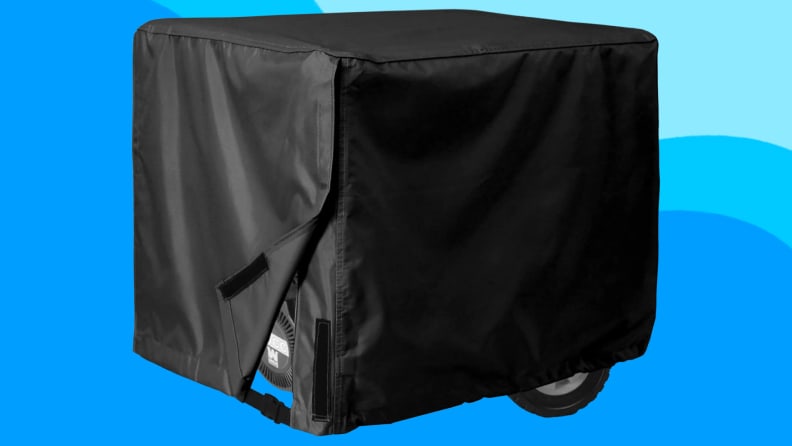
A universal generator cover can help keep dust and dirt off your machine.
Unless your backup generator is a standby generator—a device which is designed to stay outdoors—chances are you’ll be storing your machine inside, along with the gas. A garage or shed can be a safe place to keep both, provided the gas is labeled and stored in proper containers. A generator cover can also help to keep dust and moisture from accumulating on your generator when it’s not in use.



